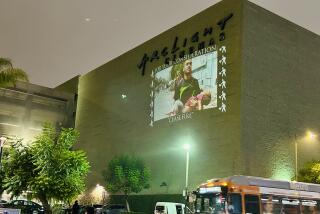Anti-billboard activists target multi-story ‘supergraphics’
- Share via
Anti-billboard activists have a new target: multi-story “supergraphic” signs plastered illegally on about three dozen buildings citywide.
A handful of West Los Angeles activists joined City Councilman Jack Weiss on West Pico Boulevard at Overland Avenue on Thursday morning to call for hefty fines against those who post the signs.
Their backdrop: a Gap Inc. supergraphic with a blond model reclining across several stories of an office building in the 10000 block of West Pico Boulevard.
The ad, which appeared in February, is a 60-foot-by-20-foot vinyl sheet stuck to the building, according to a lawyer for the company that negotiated a lease for the space. That’s 1,200 square feet compared with about 750 square feet for a traditional billboard.
A few blocks away, another supergraphic advertised “Dirt,” the new Courteney Cox show on FX. Others elsewhere in the city tout Washington Mutual and Wachovia banks.
“This is taking off because people are finding a way to get around our law,” which prohibits new billboards, Weiss said, calling the ads “sneaky” and deriding the “shrink-wrapped buildings” as “urban blight.”
Companies that post the signs defend them as free speech and say city leaders are discriminating against them by forbidding supergraphics in some areas while allowing them in others, such as Hollywood.
A lawyer for the Philadelphia-based company that posted the Gap sign, Worldwide Rush, said the company is contesting the city ban in federal court, arguing that it violates free speech.
In areas where the signs are banned, code-enforcement officials typically cite companies, then go to court to have the ads taken down, a process that can take years.
While the suits are pending, judges have barred the city from removing the supergraphics, said Nick Velasquez, a spokesman for the city attorney’s office.
“It’s visual blight, a distraction to motorists, just treating the architecture of the city as a canvas,” said Dennis Hathaway, a spokesman for the Coalition to Ban Billboard Blight.
Weiss wants the city to enforce a law already on the books that allows it to levy $2,500-a-day fines. The fines apply not only to advertisers such as Gap -- which buy the signs -- but also to the sign companies that post them and the property owners who lease the space.
The average supergraphic costs $20,000 to $200,000, depending on the size of the building, location (freeway proximity drives the price up), nearby businesses and other variables, said Matthew Cooper, a spokesman for Beverly Hills-based Skytag Inc.
Cooper said all of his company’s roughly 20 signs are in areas permitted by the city. “If it’s done right, a highly pictorial ad with a nice creative [design] can add to the landscape,” he said. “These people who just slap up these ads anywhere are giving us a bad name.”
--
molly.hennessy-[email protected]
More to Read
Sign up for Essential California
The most important California stories and recommendations in your inbox every morning.
You may occasionally receive promotional content from the Los Angeles Times.











